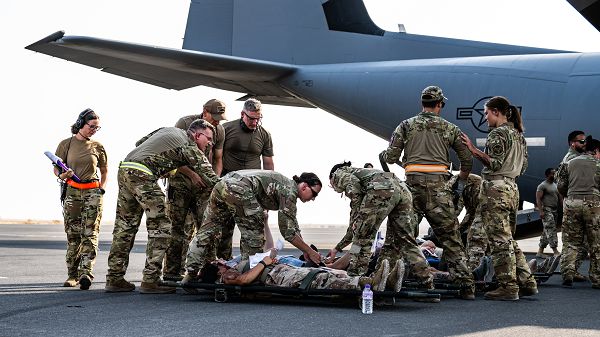
Salem Air Base, Kuwait. (August 19, 2023): American troops are told that, if they are injured in combat, they will receive lifesaving care during the “golden hour”, the time it takes to get a warfighter to a proper hospital. In this photo by Staff Sergeant Kevin Long, U.S. Air Force Medical personnel from the 386th Expeditionary Medical Squadron field response team and the 405th Expeditionary Aeromedical Evacuation Squadron prepare to load victims from a simulated attack onto a C-130J Super Hercules. This training to handle a mass-casualty event gave multiple wings and squadrons the chance to put their life-saving medical capabilities to the test.
Medical evacuation teams like these are adapting to the new reality of war against a “near peer” rival like China. In the wars in Iraq and Afghanistan, aeromedical evacuation squadrons were able to provide immediate care and swift evacuations due to American air superiority. These squadrons had the time to get a wounded warfighter off the battlefield and into a proper hospital within one hour of their being injured. Treating these patients quickly greatly improves outcomes.
This “golden hour” standard, however, may not be possible in future wars.
The near total air superiority enjoyed by U.S. units may not be the case against an adversary like China or Russia. Worse, future conflicts are likely to be large-scale operations dispersed around the world thus complicating the task of evacuating casualties quickly.
Based on these realities, American planners realize that the "golden hour" handoff to surgical teams will not be possible. This puts extreme pressure on Special Operations medics and duty corpsmen to master advanced care methods including administering pain medications, long-term pain control, airway management, and nursing skills like changing dressings. Instead of quick evacuations, injured warfighters will need to be treated near the front lines, sometimes for days.
To solve the problem, the Combat Medic Specialist Training Program has expanded its curricula to include prolonged acute care, treating traumatic wounds, sedation management, and dealing with severe burns. In addition, the program has developed an Introduction to Delayed Evacuation Care component for its 72-hour combat field training exercise.
In the next war, these medical evacuation teams and field medics will be capable of treating large numbers of casualties with limited resources for longer periods of time.


